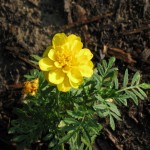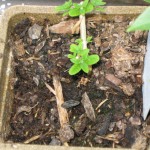 It seems that both of the dianthus specimens I moved to the lily bed are Super Parfait Raspberry. I suspect that the remaining dianthus still struggling in the purple bed is also a Super Parfait Raspberry (it comes with a marker with the name Raspberry). It appears that these Super Parfaits are intolerant of heat and the harsh Texas climate. The picoteed dianthus sitting in the corner of the purple bed has escaped identification. I am uncertain about labeling it a Telstar purple picotee since I only planted it last year. It stands to reason that it is a more recent cultivar, probably a Floral Lace dianthus. However, the foliage tends toward the lighter green of chinensis, rather than the barbatus blue and this particular specimen seems to trudge uncomfortably through our hot Texas summer. However I decided to take a cutting. With luck and some rooting hormone, I hope to duplicate it.
It seems that both of the dianthus specimens I moved to the lily bed are Super Parfait Raspberry. I suspect that the remaining dianthus still struggling in the purple bed is also a Super Parfait Raspberry (it comes with a marker with the name Raspberry). It appears that these Super Parfaits are intolerant of heat and the harsh Texas climate. The picoteed dianthus sitting in the corner of the purple bed has escaped identification. I am uncertain about labeling it a Telstar purple picotee since I only planted it last year. It stands to reason that it is a more recent cultivar, probably a Floral Lace dianthus. However, the foliage tends toward the lighter green of chinensis, rather than the barbatus blue and this particular specimen seems to trudge uncomfortably through our hot Texas summer. However I decided to take a cutting. With luck and some rooting hormone, I hope to duplicate it.
 My hopes of the bicolor salvia coccinea returning are fulfilled. The purple bed is dotted by dozens of seedlings. Some of them even made it into my planter boxes. I potted a few seedlings with the intention of filling some holes in the front yard beds. I can’t wait to see them bloom. Meanwhile, the first Victoria Blue salvia bloom in the front yard bed grabbed our attention. There are 3 specimens growing back from rootstock, surprising given the extreme winter weather we experienced. The Seabreeze salvia farinacea that I’m growing from seed seem less vigorous however. They are now being overshadowed by the Lady in Red coccinea plants. I suspect the Ladies will be ready for hardening in a week, while the Seabreezes continue to struggle. Perhaps I should have gone with the traditional Mealy Cup Sage seeds, which tend to have finer foliage, lower habit and vigorous nature than the Victorias or Seabreezes.
My hopes of the bicolor salvia coccinea returning are fulfilled. The purple bed is dotted by dozens of seedlings. Some of them even made it into my planter boxes. I potted a few seedlings with the intention of filling some holes in the front yard beds. I can’t wait to see them bloom. Meanwhile, the first Victoria Blue salvia bloom in the front yard bed grabbed our attention. There are 3 specimens growing back from rootstock, surprising given the extreme winter weather we experienced. The Seabreeze salvia farinacea that I’m growing from seed seem less vigorous however. They are now being overshadowed by the Lady in Red coccinea plants. I suspect the Ladies will be ready for hardening in a week, while the Seabreezes continue to struggle. Perhaps I should have gone with the traditional Mealy Cup Sage seeds, which tend to have finer foliage, lower habit and vigorous nature than the Victorias or Seabreezes.
 I was thrilled to find a seedling start of last year’s ornamental pepper, Purple Flash, growing next to the purple bed border. I am awaiting for it to get some height and strength before relocating it into position. My other ornamental pepper starts have begun to look livelier. In comparison to the Purple Flash, Calico seems a little weaker, less vigorous. The Calicos also appear less variegated in this stage, though here and there, they are flecked with white. Also timid from the start are the Jupiter sweet bell peppers. While the Thai chili peppers have grown fuller with their transfer outside, the bells have been flagging, attacked by unknown predators. I’ve planted the Red Rubin basil among them in hopes of deterring insects, but I feel I may have to resort to an insecticidal soon. Maybe I should replant the oregano and/or thyme in the bed to offer the peppers extra protection.
I was thrilled to find a seedling start of last year’s ornamental pepper, Purple Flash, growing next to the purple bed border. I am awaiting for it to get some height and strength before relocating it into position. My other ornamental pepper starts have begun to look livelier. In comparison to the Purple Flash, Calico seems a little weaker, less vigorous. The Calicos also appear less variegated in this stage, though here and there, they are flecked with white. Also timid from the start are the Jupiter sweet bell peppers. While the Thai chili peppers have grown fuller with their transfer outside, the bells have been flagging, attacked by unknown predators. I’ve planted the Red Rubin basil among them in hopes of deterring insects, but I feel I may have to resort to an insecticidal soon. Maybe I should replant the oregano and/or thyme in the bed to offer the peppers extra protection.
 The peppers aren’t the only plants under siege. The hostas again have become prime targets in the front yard shade bed. I’ve dusted the ground underneath them with Bayer Advanced multi-pest killer, but I think I had better results with Ortho’s EcoSense insecticidal spray Unfortunately, I believe the line has been discontinued, so I’m trying their Elementals line. I’ve been wishing for a companion planting of heucheras or scented geraniums that will protect the hostas, but it may already be too late since the damage is extensive. I should have begun sooner with a systemic solution.
The peppers aren’t the only plants under siege. The hostas again have become prime targets in the front yard shade bed. I’ve dusted the ground underneath them with Bayer Advanced multi-pest killer, but I think I had better results with Ortho’s EcoSense insecticidal spray Unfortunately, I believe the line has been discontinued, so I’m trying their Elementals line. I’ve been wishing for a companion planting of heucheras or scented geraniums that will protect the hostas, but it may already be too late since the damage is extensive. I should have begun sooner with a systemic solution.
If the scented geranium didn’t grow so tall, I would be more likely to plant them into the shade bed. But my last specimen grew up to 4 feet tall, and seem likely candidates for back of the garden planting. I’m thinking common sage might also provide some benefits, though I determined that the Tricolor I purchased last week has already displayed some damage. I’ve taken a couple of cuttings along with a Pesto Basil cutting to root and propagate under grow lights.
 I’ve returned the garlic chives back indoors, and made additional sowings in all 6 of my current pots. I’ve also begun a pot of common chives. It seems the chives respond well to regulated temperatures, and keeping them under clear plastic covers has encouraged more seed starts. I’ve also laid down a thin layer of soilless mix, and they responded even better. Taking a cue from this, I spread more of the mix on top of the marigold seeds. Even though they are said to be vigorous, I’d estimate only 25-30% of the unprotected starts germinated.
I’ve returned the garlic chives back indoors, and made additional sowings in all 6 of my current pots. I’ve also begun a pot of common chives. It seems the chives respond well to regulated temperatures, and keeping them under clear plastic covers has encouraged more seed starts. I’ve also laid down a thin layer of soilless mix, and they responded even better. Taking a cue from this, I spread more of the mix on top of the marigold seeds. Even though they are said to be vigorous, I’d estimate only 25-30% of the unprotected starts germinated.
The petunias respond extremely well to being uncovered for a few weeks. They struggled under the humidity dome for so long, and now they have quadrupled in size. I’m more conservative with the iceplants after losing the first batch of starts. Now that half of the crop are at least half an inch in size, I’ve put them out into the regular tray while keeping the weakest under cover.
All the seedings responded well to a lower grow light positioning. The impatiens in particular has shown remarkable growth. I’m debating on hardening them outside soon, with planting in the shade bed when they’ve grown strong. I wish the columbines were just as vigorous. It seems the red columbines tend to be more hearty than the blues; all of the reds germinated in this second run of columbines, where only half of the blues sprouted. In the garden setting, it seems that I am down to 4 of the remaining six columbines that survived the hardening period. I suspect that these are all reds as well.
 For future reference, annual phlox don’t respond well to indoor lighting. Even the specimen I brought indoors struggled under growlights, losing much of its foliage, but not its bloom power. I plan on replanting it into the blue garden, that is, if the yarrows don’t take over. The yarrows have begun to bloom; they are twice the size they were last year, and show no signs of stopping.
For future reference, annual phlox don’t respond well to indoor lighting. Even the specimen I brought indoors struggled under growlights, losing much of its foliage, but not its bloom power. I plan on replanting it into the blue garden, that is, if the yarrows don’t take over. The yarrows have begun to bloom; they are twice the size they were last year, and show no signs of stopping.
Alas I lost a variegated felicia, perhaps due to lack of sun. The side of the blue bed it was located in hardly received any light, though I imagine that will change with summer. I’ve been on the lookout regularly at the home improvement stores for more specimens of felicia and verbena in hopes of finding my faves again. Meanwhile, I’ve planted out one of three Blue Knoll Chrysanthemums in the blue bed. I am trying to determine space within the lines of violas to plant the other two.






























